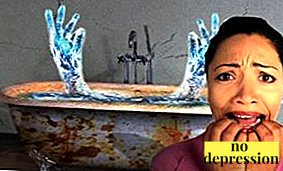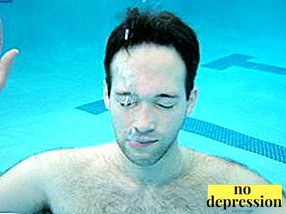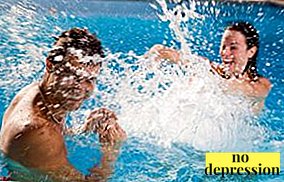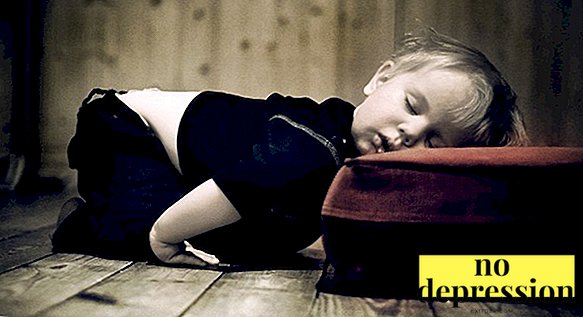The feeling of fear is a natural defense mechanism for a person. In some cases, fear becomes pathological, then talk about the occurrence of a phobia.
One of the common human phobias is hydrophobia, or the fear of water. It occurs in 15% of the population.
This pathology in psychiatry is categorized neurotic disorders. Hydrophobia delivers a lot of suffering to man, as water surrounds him everywhere, so the condition requires mandatory treatment.
What is the fear of water called?

What is hydrophobia? Hydrophobia is mental illness, manifested in uncontrolled uncontrollable fear of water.
The patient is afraid not only to go into the water, but also to be near.
In severe cases, fear spreads to drinking water and other liquids. Another name for phobias is hydrophobia, aquaphobia, fear of dampness.
Hydrophobia has various manifestations. Some people are afraid of bathing, others cannot even wash themselves with water. Based on the specifics of fears, in psychiatry there are the following types of hydrophobia:
- thalassophobia. A sick person experiences a pathological fear of the sea or ocean. He cannot even force himself to approach the edge of the shore;
- bathophobia. Pathology manifests itself in the form of fear of any deep water bodies;
- chionophobia. This is a rare disease characterized by fear of snow;
- ablutophobia. This type of hydrophobia occurs in children, is a fairly common fear, manifested in the fear of washing, taking a bath;
- potamophobia. Manifested by the fear of waterfalls or turbulent water flows. Patients can not engage in mountain tourism, go on trips to the waterfalls.
Sometimes the fear of water is combined with other phobias, for example, with brontophobia (fear of thunderstorms), as a result, a person develops a panic fear of rain.
Causes of phobias

Causes of hydrophobia may be mental and physiological.
Mental are various emotional shocks and stresses associated with the water element.
Man can be like direct participant in traumatic events, and bystander.
Sometimes aqua phobia is provoked by watching disaster films, reading books, listening to scary stories related to the negative influence of water.
Especially prone to this children, since their psyche is still very mobile. The main factors provoking the development of hydrophobia are:
- Wrong technique in teaching swimming. A child can swallow water, go deep under water. Especially often this is manifested when children are simply thrown into the water, so that they independently swim out.
- Accident on the water. This can be an inverted boat, falling into the hole in both the patient as well as the person close to him.
- Negative experience of contact with water, for example, burn with boiling water or hypothermia.
- Improper bathing of the child, for example, too fast immersion in water.
- Fear of predatory fish and other marine animals. Sometimes a person has never even seen these aquatic inhabitants, but he has heard or read a lot about them.
 Fear of depth, developed after immersion. The man experienced discomfort in the form of pressure on the ears, lack of air.
Fear of depth, developed after immersion. The man experienced discomfort in the form of pressure on the ears, lack of air.- Reading books about water disasters, watching movies, etc.
The result of this training is a strong stress and development of hydrophobia.
Provoke hydrophobia can even the fact that a person choked on water while drinking.
The physiological reasons for the appearance of aquaphobia are some diseases (tetanus, rabies) in which laryngeal edema develops. The patient can not swallow, hydrophobia develops.
If untreated, the patient dies from suffocation. If he managed to survive, then the fear of water can persist for a lifetime.
Fear of water! How to get rid from rabies? Find out from the video:
Symptoms and signs
Not all cases of hydrophobia have bright manifestations. Sometimes the patient himself can control his fear, hiding the problem from others.
Symptoms hydrophobia is divided into mental and vegetative (physiological).

Mental symptoms manifest by the following behavioral reactions:
- avoid contact with water;
- unwillingness to enter the reservoirs under any pretext;
- manifestation of nervousness and anxiety when thinking about water;
- anxiety while drinking;
- unwillingness to leave the house in the rain;
- fear of watching movies about water.
All this accompanied by obsessive thoughts, a growing depressive state.
Physiological symptoms diseases manifest as:
- dizziness;
- chills;
- increased sweating;
- shortness of breath;
- fainting;
- heart palpitations;
- seizures.
Severe hydrophobia poses the greatest danger to humans; they need specialist help.
Manifestation in children

Some baby’s water fears are manifested. in early childhood.
This is considered normal, because the child begins to learn the world.
Parents should to teach the baby to water graduallywithout making sudden movements. Usually fears pass within a year.
True hydrophobia in children reaches a peak of development in 4-5 years. They refuse to swim, dive into the water, even with the support of adults.
Sometimes parents do not take seriously the fears of the child, considering it manifestation of whims. In this case, parents forcibly force the baby to contact with water, further aggravating the situation.
With a strong degree of the disease, the baby refuses to drink water, wash, take a bath. During water procedures, the child screams, wriggles.
If you continue to contact the child with water, then a hysterical seizure may develop, the child will begin to choke or lose consciousness.
With the manifestation of such signs parents should not force baby to touch water. You should contact a specialist for help.
The baby is afraid of water. How to remove the fear of water? Psychologist tips:
Treatment

It is not necessary to engage in self-treatment of hydrophobia in order to do not aggravate the situation.
Help hydrophobia can have only a qualified psychotherapist.
Disease therapy is divided into medical and psychological. In most cases, several sessions with the psychotherapist bring positive results.
Treatment involves the use of the following methods:
- Hypnosis. Under hypnosis, the doctor suggests to the patient that water is not dangerous, that is, it creates new positive attitudes.
- Art Therapy. The patient is invited to depict on paper the subject of his fear, what he looks like. Then he draws water in a positive way.
- Visualization method. It consists in the fact that the patient represents his contact with water, describes his feelings and behavior.
- Interaction with the phobia object. The doctor teaches the patient to come into contact with water, starting from a small one, for example, from entering the knee-deep in a pond. Then the patient gradually learns to dive completely into the water at a shallow depth. In this case, the psychologist forms in the patient a positive attitude towards the water element.
The main goal of psychotherapy is the elimination of fear, the formation of a patient's calm attitude towards bathing. Children to get rid of fear is enough to learn to swim under the control of adults.
With particularly severe manifestations of aquaphobia may use drug treatment. To do this, use antidepressants, tranquilizers, antipsychotics. The choice of the drug and the duration of the course are made by the attending physician depending on the severity of the condition.
How to live with hydrophobia?

In some cases, the patient has fear not of water at all, but specific situationsrelated to water.
For example, people are afraid of oceans, floods. Also common is the fear of drowning and dying.
The first step to getting rid of the problem is awareness of the cause.
Then you should understand the absurdity of their fears. For example, read the statistics of floods or accidents on the ocean. According to statistics, such phenomena are very rare.
It helps to get rid of the fears of watching movies, which shows the positive stories related to water.
From fear drown You can also get rid of yourself. This should be done gradually:
- Choose a beautiful and safe place for swimming with a gentle shore.
- To arrange a pleasant meeting with friends on the beach so that joyful impressions remain from the proximity of the water.
- Constantly inspire yourself that water is not dangerous. You can listen to the sound of the surf, view beautiful pictures of the river or the sea.
- Learn to swim gradually: first go into the water on the knee, then to the waist, each time to increase the time spent in the water.
 The next stage - the implementation of swimming movements in shallow water. The feeling of closeness of the bottom helps to overcome fear.
The next stage - the implementation of swimming movements in shallow water. The feeling of closeness of the bottom helps to overcome fear.
By following these simple guidelines, the patient can deal with the problem.
Of course, it will take some time. In the case of hydrophobia, the treatment prognosis is favorable.
Faced with a pathological fear, the patient should not be locked in his trouble. Help in the fight against phobia can only positive attitude and support of loved ones.
How to overcome the fear of drowning? Exercises in the pool:

 Fear of depth, developed after immersion. The man experienced discomfort in the form of pressure on the ears, lack of air.
Fear of depth, developed after immersion. The man experienced discomfort in the form of pressure on the ears, lack of air. The next stage - the implementation of swimming movements in shallow water. The feeling of closeness of the bottom helps to overcome fear.
The next stage - the implementation of swimming movements in shallow water. The feeling of closeness of the bottom helps to overcome fear.

